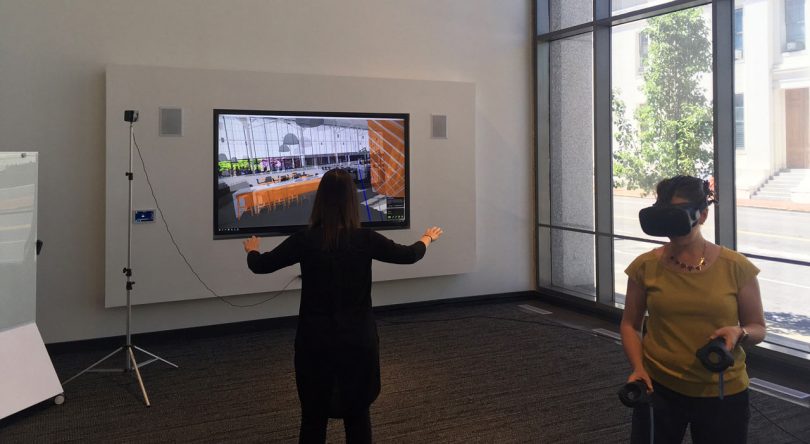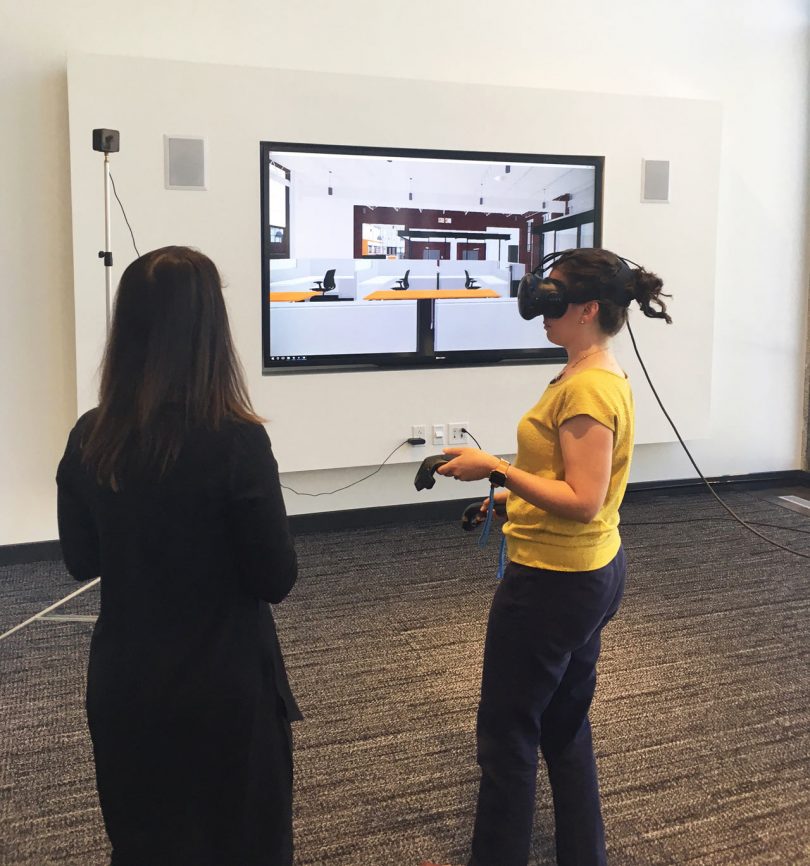How Virtual Reality Is Changing the World of Interior Design
In our increasingly digitized world, where everything from our phones to our thermostats is “smart,” it should come as no surprise that virtual reality (VR) and augmented reality (AR) are starting to play a role in the design industry. It’s a logical relationship: designers have always imagined new or re-imagined existing spaces, created a drawing via analog means or digital ones, and presented that visualization to their clients. It tracks, then, that as drawing technology has advanced from paper, onto a screen, and finally into a three-dimensional projection, designers have adapted to the times.

Courtesy of HOK

Courtesy of HOK
For the average user, virtual reality might be more of a novelty than a helpful tool, best reserved for gaming, amusement-park simulator rides, or a fun “experience,” like walking on the moon. But its practical applications are manifold, from helping doctors practice difficult surgeries to teaching teenagers how to drive cars safely to allowing jurors in a courtroom to virtually visit a crime scene. In the interior design field, however, VR technology is actually less about helping designers who are creating works and more about helping them communicate those ideas to clients.

Courtesy of HOK
“While designers are used to interpreting 2D representations of designs like floor plans, elevations, and finish boards, non-design professionals typically have more trouble visualizing the experience of being in spaces proposed by 2D representations,” says Jess Bayuk, a design technology specialist in global design firm HOK’s New York office. “Virtual reality and augmented reality allows viewers to get a better sense of how a space will look and feel in a 3D mode of representation that is more like the everyday experience.”

Courtesy of Primer
That’s why there has been such a proliferation of augmented reality design apps in the consumer market. Take the app Primer, for instance, which launches on March 31. Users will be able to use their phone’s camera to virtually install real-life wallpapers, paints, and tiles from brands like Farrow & Ball, Hygge & West, and Cle Tile into their home, allowing them to visualize what each product will look like under the room’s lighting conditions and existing furniture. “With Primer, all the guesswork is removed – customers no longer have to visualize what a pattern will look like in their home, because the app shows them,” Hygge & West co-founder Aimee Lagos said in a statement. “Primer lets people buy with confidence, and confident purchases make happy homes.”

Courtesy of IKEA
There are also a plethora of AR apps designed to place furniture in your home. Some brands, like IKEA and Pottery Barn, have developed their own apps to showcase their collections, while others, like DecorMatters and roOomy, tap into a range of commercially available products. And if you need to measure a room? There’s also an app for that. Cubit, which we’ve previously reviewed, combines analog technology (in this case, lasers and a rolling sensor) with augmented reality, allowing you to take precise measurements of a space and immediately project them onto a live feed of that space via an app and your phone’s camera.
But professional designers are finding more ways to use the technology to their advantage. “HOK designers also use VR and AR for projects like labs and clinical spaces to share adjacencies and verify that designs will work with desired workflows,” says Bayuk. “We can then review the programming in detail with the researchers and clinicians who will use the spaces.”

Courtesy of HOK
Beyond that, HOK has even developed its own VR app – one that anyone in the industry or the general public can download for free – in order to better facilitate its own design processes. “The HOK VR App enables users to quickly upload 360-degree panoramas and package them in a way that is easy to share during a design team charrette or client review,” says Bayuk. “The app also allows for VR meetings where multiple stakeholders can view VR panoramas together in real time, and then comment and annotate them collaboratively.”
While for now, designers might stick to sketches when conjuring up their ideas, there may be a near future in which you can enter a Matrix-style virtual space and mold it to your liking with a simple hand gesture or even just a glance. And given this virulent world we live in, these kinds of virtual tools may become a necessity.
Stefanie Waldek is a Brooklyn-based writer covering architecture, design, and travel. You can find her words in Architectural Digest, Condé Nast Traveler, House Beautiful, Business Insider, The Washington Post, and more.
AR, Art, augmented reality, Design, Entertainment, Inspiration, Interior Design, Main, Technology, Virtual Reality, VR
AR, Art, augmented reality, Design, Entertainment, Inspiration, Interior Design, Main, Technology, Virtual Reality, VR
0 Response to "How Virtual Reality Is Changing the World of Interior Design"
Kommentar veröffentlichen